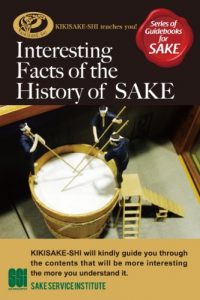Introduction
It is said that the history of Sake dates back to about two thousand years, but did you know that the foundation of the current Sake brewing was already completed during the Edo period?
Sake brewing has directly experienced many difficult times in history such as taxation, war, and law. The Sake breweries existing today exist because they have overcome such ordeals.
The fundamental value of Sake can be seen by understanding the history, such as the closing down of business, the confusion due to the War, and the arrival of a new boom with the revision of the law.
The present situation is that many of the Japanese people do not know much about Sake.
However, is it really OK to not know anything about Sake, which is a part of our culture?
Our Kikisake-shi will kindly guide you through the contents that will be more interesting the more you understand it.
----------------------------------------
Index
Introduction
Chp1. 縄文Jomon period to 弥生Yayoi period
1. The first alcoholic beverage in Japan was wine
2. Brewing was women's job at the beginning
1. What is 口噛みの酒Kuchikami-no Sake?
Chp2. 古墳Kofun and 飛鳥Asuka period to 奈良Nara period
4. The roots of the word “Sake”
5. The god of Sake in 出雲Izumo
6. China brought Sake using 麹Koji “rice malt” to Japan
7. The roots of Sake in 濁酒Doburoku
8. A position that specializes in Sake in the imperial court during Nara period
Chp3. 平安Heian period to 鎌倉Kamakura and 室町Muromachi period to 安土桃山Azuchi Momoyama period
9. What is 僧坊酒Soboshu?
10. 諸白Morohaku, 片白Katahaku, and the origin of 清酒Seishu “clear Sake”
11. Japan's prohibition of alcohol
12. Missionaries in Japan had written about the Japanese Sake culture
13. 地酒Jizake “local Sake” in Muromachi period
Chp4. 江戸Edo period to 明治Meiji and 大正Taisho period
14. Making Sake in the winter started in Edo period
15. The relationship between Sake brewing and the policy of increasing wealth and military power
16. When did Sake exporting begin?
17. Why did Doburoku go downhill?
18. Sake brewing expanded under the ministry of finance
19. 一升瓶Issho-bin “1.8 liter bottle of Sake” was developed to prevent frauds
20. Toji were migrant workers
Chp5. 昭和Showa period
21. The Pacific War changed the Sake industry
22. What is 三増酒Sanzo-shu that supported post-war Japan?
23. What is distilled alcohol?
24. Are antiseptic materials used in Sake?
25. What is the amount of the Sake production at peak?
26. 桶買いOke-gai and 桶売りOke-uri were tax strategies
27. What happened after the abolition of 級別制度Kyubetsu-seido “Sake classification system”
Chp6. 平成Heisei period
28. Is it difficult to obtain Sake licence?
29. How did the boom of 吟醸酒Ginjo-shu occur?
30. Why did the Sake consumption decrease?
31. Is Sake produced overseas?
32. What is 國酒Kokushu project?
Postscript
About Kikisake-shi, the Japanese missionaries in the Japanese Sake culture
Writer's profile Sake Service Institute
Editor's profile Food & Beverage Specialists Organization
Master of SAKE The textbook of KIKISAKE-SHI
It is said that the history of Sake dates back to about two thousand years, but did you know that the foundation of the current Sake brewing was already completed during the Edo period?
Sake brewing has directly experienced many difficult times in history such as taxation, war, and law. The Sake breweries existing today exist because they have overcome such ordeals.
The fundamental value of Sake can be seen by understanding the history, such as the closing down of business, the confusion due to the War, and the arrival of a new boom with the revision of the law.
The present situation is that many of the Japanese people do not know much about Sake.
However, is it really OK to not know anything about Sake, which is a part of our culture?
Our Kikisake-shi will kindly guide you through the contents that will be more interesting the more you understand it.
----------------------------------------
Index
Introduction
Chp1. 縄文Jomon period to 弥生Yayoi period
1. The first alcoholic beverage in Japan was wine
2. Brewing was women's job at the beginning
1. What is 口噛みの酒Kuchikami-no Sake?
Chp2. 古墳Kofun and 飛鳥Asuka period to 奈良Nara period
4. The roots of the word “Sake”
5. The god of Sake in 出雲Izumo
6. China brought Sake using 麹Koji “rice malt” to Japan
7. The roots of Sake in 濁酒Doburoku
8. A position that specializes in Sake in the imperial court during Nara period
Chp3. 平安Heian period to 鎌倉Kamakura and 室町Muromachi period to 安土桃山Azuchi Momoyama period
9. What is 僧坊酒Soboshu?
10. 諸白Morohaku, 片白Katahaku, and the origin of 清酒Seishu “clear Sake”
11. Japan's prohibition of alcohol
12. Missionaries in Japan had written about the Japanese Sake culture
13. 地酒Jizake “local Sake” in Muromachi period
Chp4. 江戸Edo period to 明治Meiji and 大正Taisho period
14. Making Sake in the winter started in Edo period
15. The relationship between Sake brewing and the policy of increasing wealth and military power
16. When did Sake exporting begin?
17. Why did Doburoku go downhill?
18. Sake brewing expanded under the ministry of finance
19. 一升瓶Issho-bin “1.8 liter bottle of Sake” was developed to prevent frauds
20. Toji were migrant workers
Chp5. 昭和Showa period
21. The Pacific War changed the Sake industry
22. What is 三増酒Sanzo-shu that supported post-war Japan?
23. What is distilled alcohol?
24. Are antiseptic materials used in Sake?
25. What is the amount of the Sake production at peak?
26. 桶買いOke-gai and 桶売りOke-uri were tax strategies
27. What happened after the abolition of 級別制度Kyubetsu-seido “Sake classification system”
Chp6. 平成Heisei period
28. Is it difficult to obtain Sake licence?
29. How did the boom of 吟醸酒Ginjo-shu occur?
30. Why did the Sake consumption decrease?
31. Is Sake produced overseas?
32. What is 國酒Kokushu project?
Postscript
About Kikisake-shi, the Japanese missionaries in the Japanese Sake culture
Writer's profile Sake Service Institute
Editor's profile Food & Beverage Specialists Organization
Master of SAKE The textbook of KIKISAKE-SHI












